YAMAHA PW50 2010 Workshop Manual
Manufacturer: YAMAHA, Model Year: 2010, Model line: PW50, Model: YAMAHA PW50 2010Pages: 70, PDF Size: 1.44 MB
Page 51 of 70
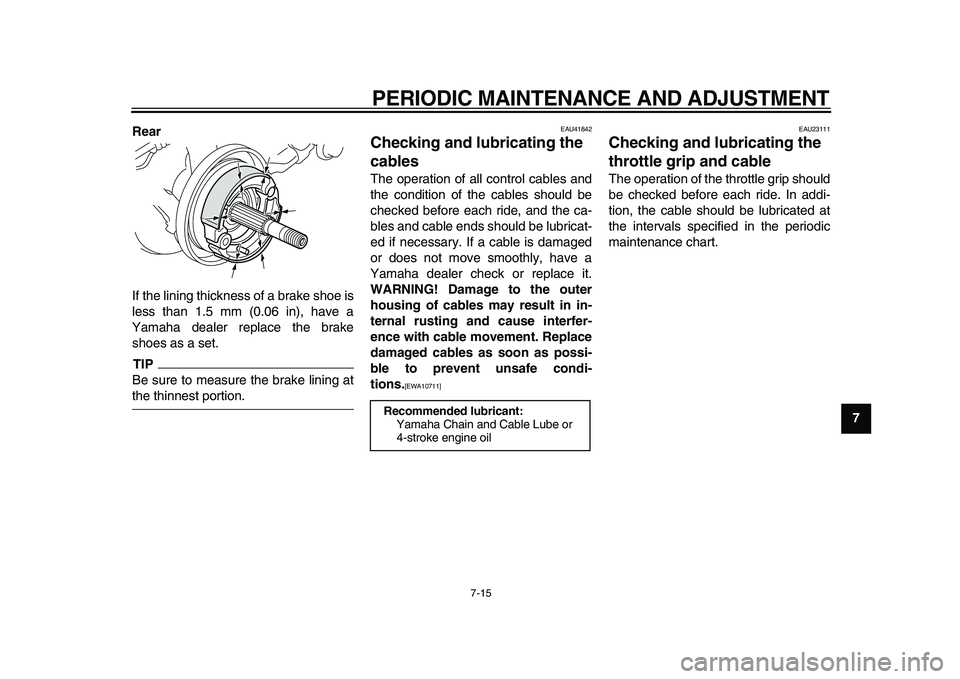
PERIODIC MAINTENANCE AND ADJUSTMENT
7-15
2
3
4
5
6
78
9 Rear
If the lining thickness of a brake shoe is
less than 1.5 mm (0.06 in), have a
Yamaha dealer replace the brake
shoes as a set.
TIP
Be sure to measure the brake lining at
the thinnest portion.
EAU41842
Checking and lubricating the
cables
The operation of all control cables and
the condition of the cables should be
checked before each ride, and the ca-
bles and cable ends should be lubricat-
ed if necessary. If a cable is damaged
or does not move smoothly, have a
Yamaha dealer check or replace it.
WARNING! Damage to the outer
housing of cables may result in in-
ternal rusting and cause interfer-
ence with cable movement. Replace
damaged cables as soon as possi-
ble to prevent unsafe condi-
tions.
[EWA10711]
EAU23111
Checking and lubricating the
throttle grip and cable
The operation of the throttle grip should
be checked before each ride. In addi-
tion, the cable should be lubricated at
the intervals specified in the periodic
maintenance chart.
Recommended lubricant:
Yamaha Chain and Cable Lube or
4-stroke engine oil
Page 52 of 70
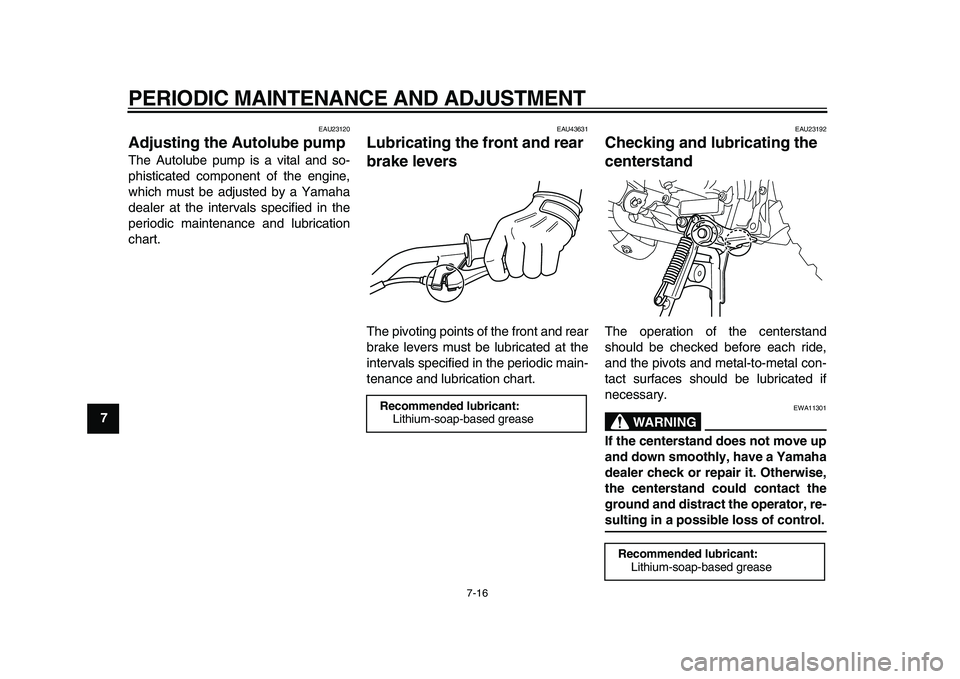
PERIODIC MAINTENANCE AND ADJUSTMENT
7-16
1
2
3
4
5
6
7
8
9
EAU23120
Adjusting the Autolube pump
The Autolube pump is a vital and so-
phisticated component of the engine,
which must be adjusted by a Yamaha
dealer at the intervals specified in the
periodic maintenance and lubrication
chart.
EAU43631
Lubricating the front and rear
brake levers
The pivoting points of the front and rear
brake levers must be lubricated at the
intervals specified in the periodic main-
tenance and lubrication chart.
EAU23192
Checking and lubricating the
centerstand
The operation of the centerstand
should be checked before each ride,
and the pivots and metal-to-metal con-
tact surfaces should be lubricated if
necessary.
WARNING
EWA11301
If the centerstand does not move up
and down smoothly, have a Yamaha
dealer check or repair it. Otherwise,
the centerstand could contact the
ground and distract the operator, re-
sulting in a possible loss of control.
Recommended lubricant:
Lithium-soap-based grease
Recommended lubricant:
Lithium-soap-based grease
Page 53 of 70

PERIODIC MAINTENANCE AND ADJUSTMENT
7-17
2
3
4
5
6
78
9
EAU42081
Checking the front fork
The condition and operation of the front
fork must be checked as follows at the
intervals specified in the periodic main-
tenance and lubrication chart.
To check the condition
Check the inner tubes for scratches
and damage.
To check the operation
1. Place the vehicle on a level sur-
face and hold it in an upright posi-
tion.
WARNING! To avoid injury,
securely support the vehicle so
there is no danger of it falling
over.
[EWA10751]
2. While applying the front brake,
push down hard on the handlebars
several times to check if the front
fork compresses and rebounds
smoothly.
NOTICE
ECA10590
If any damage is found or the front
fork does not operate smoothly,
have a Yamaha dealer check or re-
pair it.
EAU45511
Checking the steering
Worn or loose steering bearings may
cause danger. Therefore, the operation
of the steering must be checked as fol-
lows at the intervals specified in the pe-
riodic maintenance and lubrication
chart.
1. Place the vehicle on the center-
stand.
WARNING! To avoid inju-
ry, securely support the vehicle
so there is no danger of it falling
over.
[EWA10751]
2. Hold the lower ends of the front
fork legs and try to move them for-
ward and backward. If any free
play can be felt, have a Yamaha
dealer check or repair the steering.
Page 54 of 70
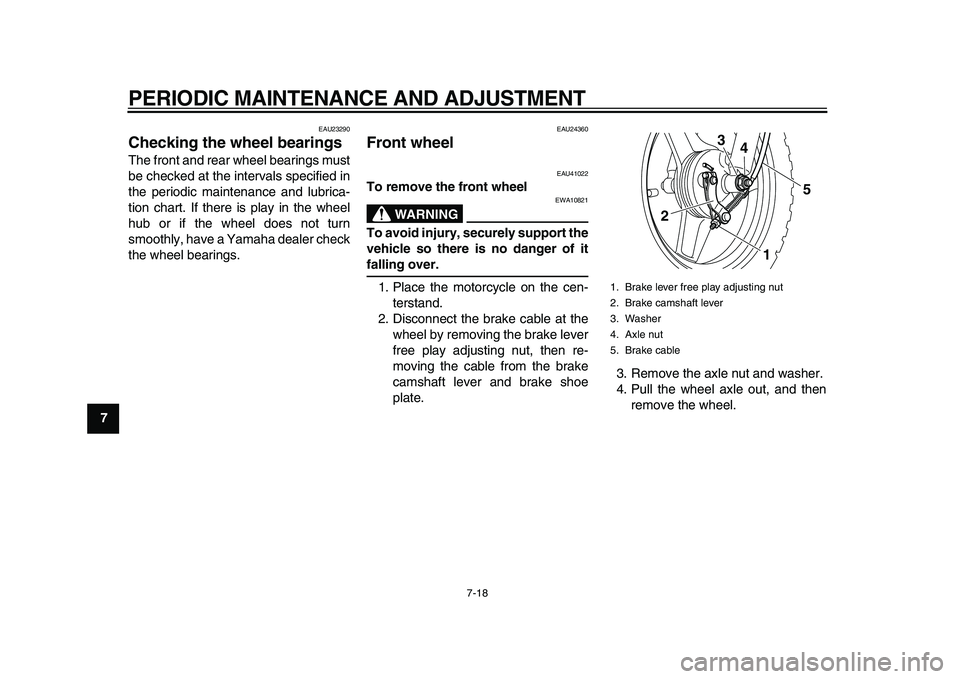
PERIODIC MAINTENANCE AND ADJUSTMENT
7-18
1
2
3
4
5
6
7
8
9
EAU23290
Checking the wheel bearings
The front and rear wheel bearings must
be checked at the intervals specified in
the periodic maintenance and lubrica-
tion chart. If there is play in the wheel
hub or if the wheel does not turn
smoothly, have a Yamaha dealer check
the wheel bearings.
EAU24360
Front wheel
EAU41022
To remove the front wheel
WARNING
EWA10821
To avoid injury, securely support the
vehicle so there is no danger of it
falling over.
1. Place the motorcycle on the cen-
terstand.
2. Disconnect the brake cable at the
wheel by removing the brake lever
free play adjusting nut, then re-
moving the cable from the brake
camshaft lever and brake shoe
plate.3. Remove the axle nut and washer.
4. Pull the wheel axle out, and then
remove the wheel.
1. Brake lever free play adjusting nut
2. Brake camshaft lever
3. Washer
4. Axle nut
5. Brake cable
5
1 23
4
Page 55 of 70
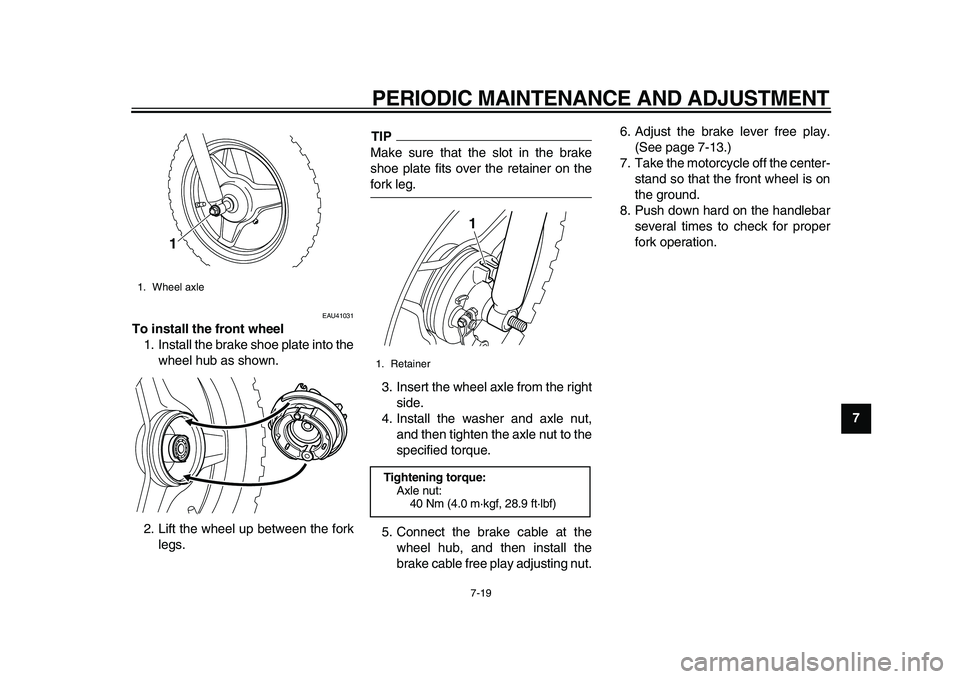
PERIODIC MAINTENANCE AND ADJUSTMENT
7-19
2
3
4
5
6
78
9
EAU41031
To install the front wheel
1. Install the brake shoe plate into the
wheel hub as shown.
2. Lift the wheel up between the fork
legs.
TIP
Make sure that the slot in the brake
shoe plate fits over the retainer on the
fork leg.
3. Insert the wheel axle from the right
side.
4. Install the washer and axle nut,
and then tighten the axle nut to the
specified torque.
5. Connect the brake cable at the
wheel hub, and then install the
brake cable free play adjusting nut.6. Adjust the brake lever free play.
(See page 7-13.)
7. Take the motorcycle off the center-
stand so that the front wheel is on
the ground.
8. Push down hard on the handlebar
several times to check for proper
fork operation.
1. Wheel axle
1
1. Retainer
Tightening torque:
Axle nut:
40 Nm (4.0 m·kgf, 28.9 ft·lbf)
1
Page 56 of 70
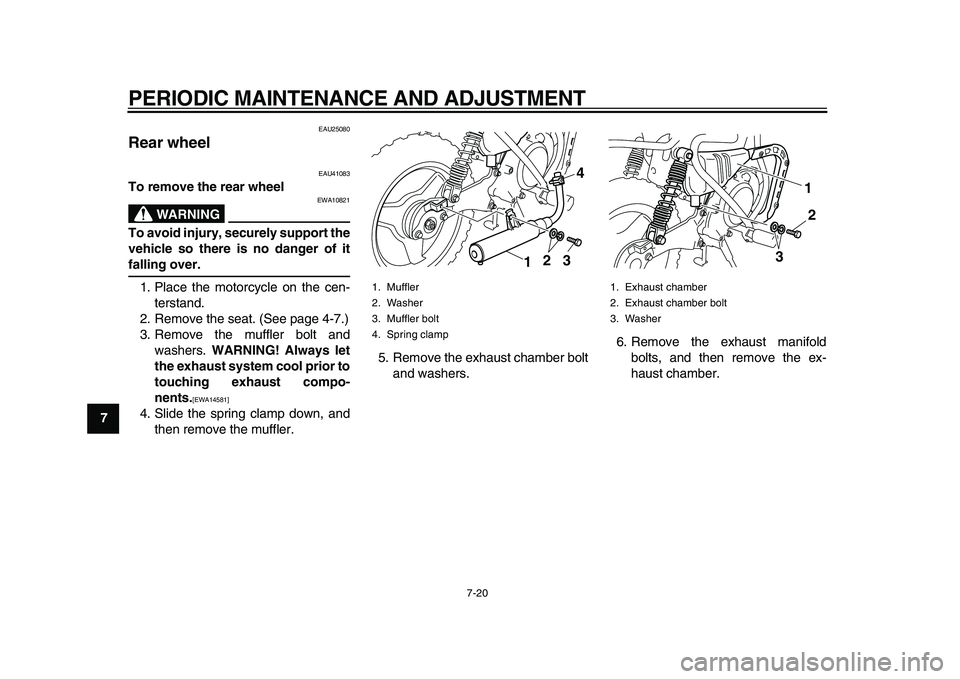
PERIODIC MAINTENANCE AND ADJUSTMENT
7-20
1
2
3
4
5
6
7
8
9
EAU25080
Rear wheel
EAU41083
To remove the rear wheel
WARNING
EWA10821
To avoid injury, securely support the
vehicle so there is no danger of it
falling over.
1. Place the motorcycle on the cen-
terstand.
2. Remove the seat. (See page 4-7.)
3. Remove the muffler bolt and
washers.
WARNING! Always let
the exhaust system cool prior to
touching exhaust compo-
nents.
[EWA14581]
4. Slide the spring clamp down, and
then remove the muffler.5. Remove the exhaust chamber bolt
and washers.6. Remove the exhaust manifold
bolts, and then remove the ex-
haust chamber.
1. Muffler
2. Washer
3. Muffler bolt
4. Spring clamp
3
1
24
1. Exhaust chamber
2. Exhaust chamber bolt
3. Washer
2 1
3
Page 57 of 70
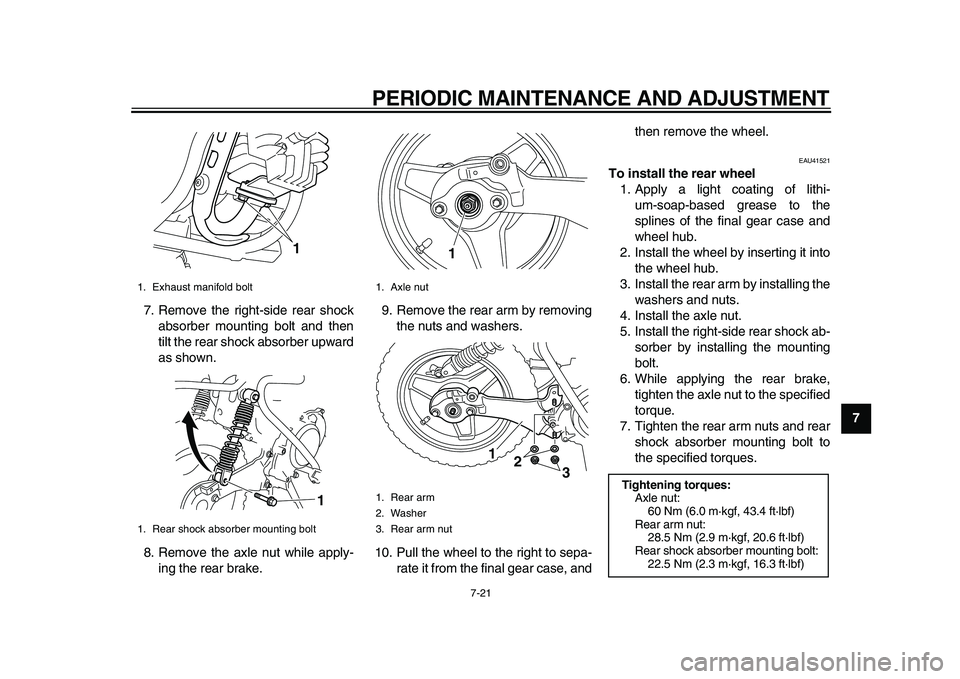
PERIODIC MAINTENANCE AND ADJUSTMENT
7-21
2
3
4
5
6
78
9
7. Remove the right-side rear shock
absorber mounting bolt and then
tilt the rear shock absorber upward
as shown.
8. Remove the axle nut while apply-
ing the rear brake.9. Remove the rear arm by removing
the nuts and washers.
10. Pull the wheel to the right to sepa-
rate it from the final gear case, andthen remove the wheel.
EAU41521
To install the rear wheel
1. Apply a light coating of lithi-
um-soap-based grease to the
splines of the final gear case and
wheel hub.
2. Install the wheel by inserting it into
the wheel hub.
3. Install the rear arm by installing the
washers and nuts.
4. Install the axle nut.
5. Install the right-side rear shock ab-
sorber by installing the mounting
bolt.
6. While applying the rear brake,
tighten the axle nut to the specified
torque.
7. Tighten the rear arm nuts and rear
shock absorber mounting bolt to
the specified torques.
1. Exhaust manifold bolt
1. Rear shock absorber mounting bolt
1
1
1. Axle nut
1. Rear arm
2. Washer
3. Rear arm nut1
1
2
3
Tightening torques:
Axle nut:
60 Nm (6.0 m·kgf, 43.4 ft·lbf)
Rear arm nut:
28.5 Nm (2.9 m·kgf, 20.6 ft·lbf)
Rear shock absorber mounting bolt:
22.5 Nm (2.3 m·kgf, 16.3 ft·lbf)
Page 58 of 70
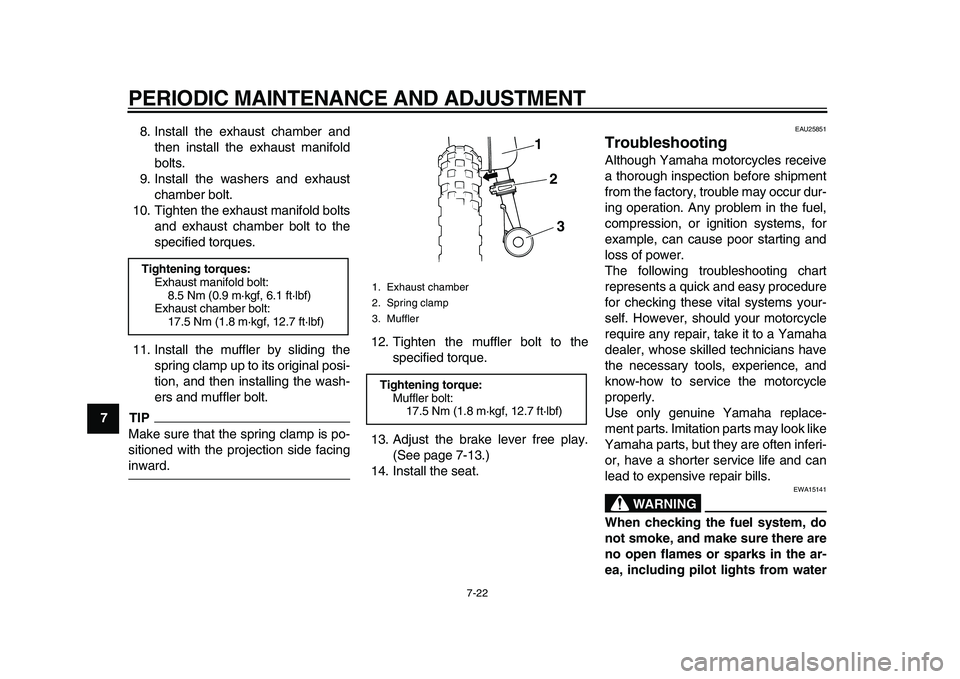
PERIODIC MAINTENANCE AND ADJUSTMENT
7-22
1
2
3
4
5
6
7
8
9
8. Install the exhaust chamber and
then install the exhaust manifold
bolts.
9. Install the washers and exhaust
chamber bolt.
10. Tighten the exhaust manifold bolts
and exhaust chamber bolt to the
specified torques.
11. Install the muffler by sliding the
spring clamp up to its original posi-
tion, and then installing the wash-
ers and muffler bolt.
TIP
Make sure that the spring clamp is po-
sitioned with the projection side facing
inward.12. Tighten the muffler bolt to the
specified torque.
13. Adjust the brake lever free play.
(See page 7-13.)
14. Install the seat.
EAU25851
Troubleshooting
Although Yamaha motorcycles receive
a thorough inspection before shipment
from the factory, trouble may occur dur-
ing operation. Any problem in the fuel,
compression, or ignition systems, for
example, can cause poor starting and
loss of power.
The following troubleshooting chart
represents a quick and easy procedure
for checking these vital systems your-
self. However, should your motorcycle
require any repair, take it to a Yamaha
dealer, whose skilled technicians have
the necessary tools, experience, and
know-how to service the motorcycle
properly.
Use only genuine Yamaha replace-
ment parts. Imitation parts may look like
Yamaha parts, but they are often inferi-
or, have a shorter service life and can
lead to expensive repair bills.
WARNING
EWA15141
When checking the fuel system, do
not smoke, and make sure there are
no open flames or sparks in the ar-
ea, including pilot lights from water
Tightening torques:
Exhaust manifold bolt:
8.5 Nm (0.9 m·kgf, 6.1 ft·lbf)
Exhaust chamber bolt:
17.5 Nm (1.8 m·kgf, 12.7 ft·lbf)
1. Exhaust chamber
2. Spring clamp
3. Muffler
Tightening torque:
Muffler bolt:
17.5 Nm (1.8 m·kgf, 12.7 ft·lbf)
1
2
3
Page 59 of 70
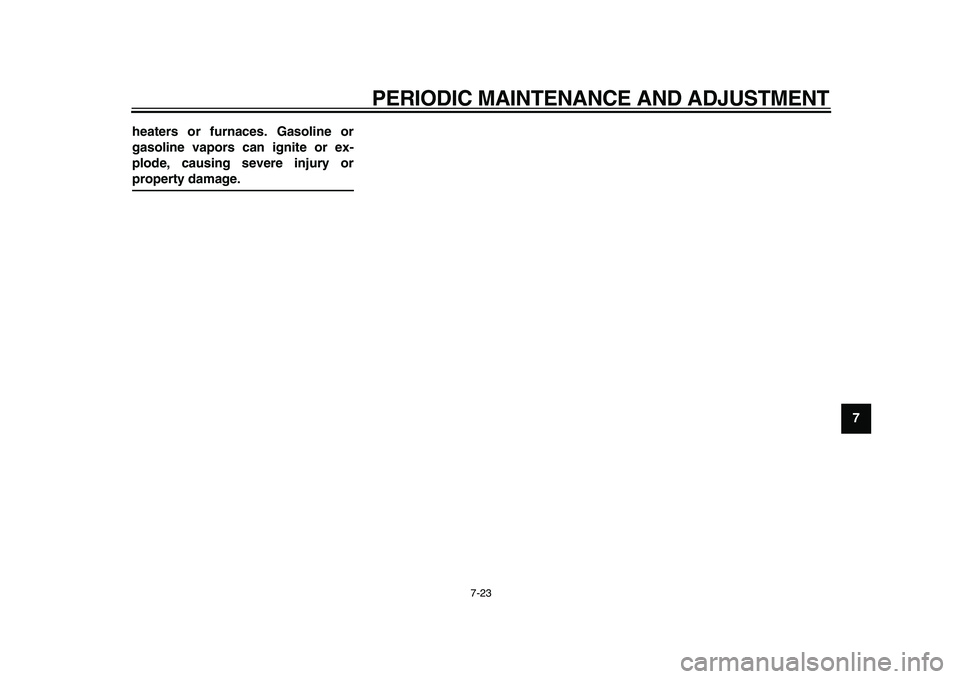
PERIODIC MAINTENANCE AND ADJUSTMENT
7-23
2
3
4
5
6
78
9 heaters or furnaces. Gasoline or
gasoline vapors can ignite or ex-
plode, causing severe injury or
property damage.
Page 60 of 70
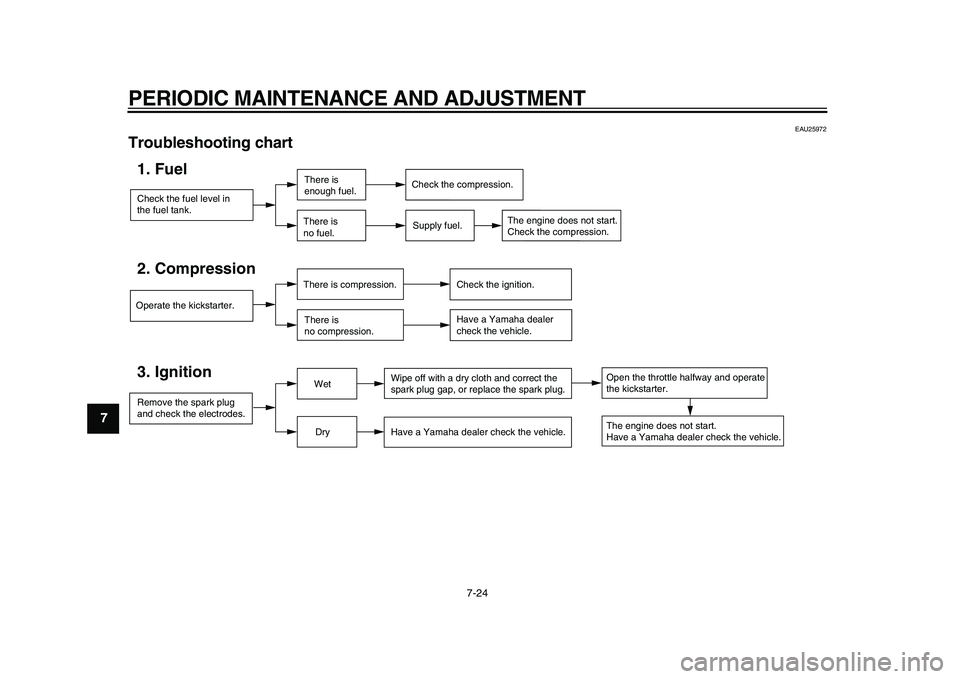
PERIODIC MAINTENANCE AND ADJUSTMENT
7-24
1
2
3
4
5
6
7
8
9
EAU25972
Troubleshooting chart
Check the fuel level in
the fuel tank.1. Fuel
There is
enough fuel.
There is
no fuel.
Supply fuel.
Operate the kickstarter.2. Compression
There is compression.
There is
no compression.Check the ignition.
Have a Yamaha dealer
check the vehicle.
Remove the spark plug
and check the electrodes.3. Ignition
Wet
DryWipe off with a dry cloth and correct the
spark plug gap, or replace the spark plug.
Have a Yamaha dealer check the vehicle.The engine does not start.
Have a Yamaha dealer check the vehicle.
Open the throttle halfway and operate
the kickstarter.
Check the compression.
The engine does not start.
Check the compression.